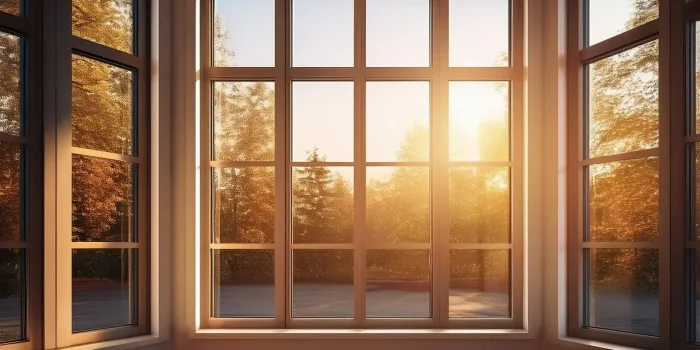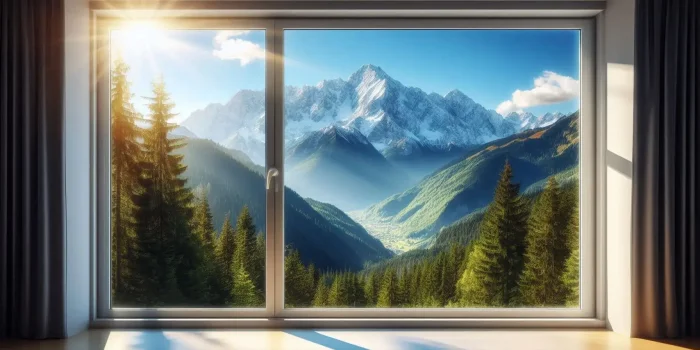Ever wondered how the right window can transform your room’s ambiance? You’re not alone. Windows are more than just a source of natural light; they’re a pivotal design element that can dramatically alter your home’s aesthetics.
From classic to contemporary, there’s a myriad of window styles to choose from. Each style not only changes how your home looks but also how you interact with the outside world. Whether you’re renovating your dream home or building from scratch, understanding the different window styles can help you make an informed choice.
In this article, we’ll delve into the world of window styles, exploring their unique characteristics and how they can enhance your living space. So, let’s embark on this journey to find the perfect window for your home.
Understanding Basic Window Terminology
Let’s dive a bit deeper into the world of windows. Understanding the terminology can greatly assist you in choosing the perfect window style for your home or office.
Parts of a Window
- Pane: This refers to a single sheet of glass in a window. For instance, a six-pane window means it’s divided into six glazed squares or rectangles.
- Sash: It’s the framework that holds the panes of glass. So, it’s a single unit of glass. The terms ‘upper sash’ and ‘lower sash’ are commonly used in the context of double-hung windows.
- Glazing: This term could have two meanings. It either denotes the glass portion of a window or the method of installing a glass into a window frame. Double-glazed windows, for example, have two sheets of glass with a space in between for better insulation.
- Frame: As the name indicates, it’s the skeleton that holds the sash and the panes in place. Depending on the aesthetic you’re going for and your budget, the frame could be made from a variety of materials, such as wood, vinyl, aluminum, or even a mix of these.
Window Operation Modes
- Operable Windows: This type of windows can be opened, allowing fresh air inside. Single-hung, double-hung, casement, and slider windows are a few good examples. In the US, about 67% of homes have at least one type of operable window.
- Fixed Windows: On the contrary, these windows do not open. They’re commonly used to enhance views or increase the amount of natural light in a room. Picture windows, for instance, are a popular type of fixed window and you’ll likely see them in about 75% of modern houses.
Different Types of Window Styles
Now that you’re well-versed in basic window terminology, let’s delve into various window styles. Each type has its unique quirks, advantages, and setbacks, impacting not just the aesthetics but also functionality and energy efficiency in your living spaces.
1. Double Hung Windows
Sure, it’s a classic. But the timeless design of Double Hung Windows goes beyond its charming appeal. With two operable sashes that slide vertically, it bestows upon homeowners an increased control over ventilation.
Pros you may relish:
- Optimal ventilation due to both sashes opening, perfect for those breezy summer evening.
- Single windows prove decent; two hung windows offer better insulation, potentially reducing heating and cooling costs by up to 15%.
- The versatile design complements a range of architectural styles, from colonial to craftsman.
Not all sunshine and rainbows, the cons include:
- Higher cost, generally 10-50% more than single hung windows due to intricate design.
- Larger sizes can possibly lose their structural integrity over time, leading to sagging.
- Sashes will require occasional lubrication and adjustment, perhaps every two to four years, for smooth functioning.
2. Casement Windows
Moving from the classic to the practical, Casement Windows fuses ease of use with function. Designed to open outward with a crank handle, this style gives you unmatched control over airflow direction.
Reasons to love them:
- Easy to operate, making them ideal for hard-to-reach places like over the kitchen sink.
- Excellent airflow control, you can direct the breeze based on how much and at what angle you wish to open the window.
- With no bar down the middle, they provide an unobstructed view to the outside world.
Cons to keep in mind:
- Not ideal for high-traffic exterior areas like decks or patios as they open outwards.
- More moving parts mean more maintenance.
- With visible crank handles, they might not blend easily with all decor styles.
3. Sliding Windows
If it’s a clear, extended view of the outdoors you’re after, Sliding Windows might be your pick. As the name suggests, these windows slide horizontally and provide a wider view compared to double or single hung windows.
What makes them special:
- Easy operation with a simple slide mechanism.
- Clear, unobstructed view providing a panorama of your surroundings.
- Lower maintenance as they’ve fewer parts to break or wear out over time.
- Economically friendly, typically less expensive than other styles.
Potential drawbacks include:
- One fixed panel restricts ventilation since only half of the window can be open at any given time.
- Ensuring a tight seal can pose problems in the long run.
4. Picture Windows
When the view is too good to ignore, Picture Windows capture and frame it like a piece of art. Predominantly large, these windows do not open and therefore are often combined with other window styles for ventilation.
Why you might want them:
- The larger the window, the more natural light you get. In turn, this could lower energy costs by reducing the need for artificial light.
- Unparalleled views as they’re usually designed to showcase a pretty outdoor scene.
- Since they don’t open, there are no mechanical parts to maintain. Talk about low maintenance!
Yet, you might consider these issues:
- Zero ventilation. As these windows don’t open, they’re not suitable for areas needing air circulation.
- Overexposure to sunlight can lead to increased energy costs and potential UV damage to the inside spaces.
5. Bay or Bow Windows
Finally, for those looking to add visual interest or extra square footage, Bay or Bow Windows are worth considering. These styles extend outward from the house, creating a panoramic view and a cozy alcove indoors.
Perks of having them:
- Increase in square footage, ideal for a cute reading nook or extra storage space.
- Enhances the exterior aesthetic of your home, increasing its curb appeal.
- Improved natural light and ventilation due to multiple angles of openings.
However, they come with:
- Higher upfront cost due to their complex installation.
- Increased exposure might require additional window treatments for privacy.
- They’re an investment not just in budget, but also in maintenance and upkeep.
Now you’re loaded with all the deets on different window styles! The choice, as always, lies in your hands depending on your aesthetic preference, functional needs, and budget.
Benefits and Drawbacks of Different Window Styles
Understanding the pros and cons of various window styles can dramatically impact your home’s functionality, aesthetics, and comfort levels. Let’s break down some popular window styles for a clearer, more informed decision.
Pros and Cons of Double Hung Windows
Pros:
- Operability: With Double Hung Windows, you enjoy the luxury of operating both sashes, allowing for exceptional ventilation and easier cleaning.
- Safety: They come with a tilt-in feature for your peace of mind. This feature enhances safety, particularly for homes with small children, and makes cleaning from the interior a breeze.
- Versatility: Their availability in numerous sizes makes them a suitable choice for locations with ample height and width.
- Energy Efficiency: Want to boost your green credentials? Double Hung Windows can be designed with energy-efficient features like double or triple panes.
Cons:
- Cost: These windows typically come at a higher price tag compared to single-hung counterparts.
- Maintenance: The moving parts might wear out over time, necessitating occasional maintenance.
- Leaks: Compared to fixed windows, there’s a slightly higher risk of water and air leaks.
Pros and Cons of Casement Windows
Pros:
- Visibility: Casement windows offer unobstructed views since they lack rails, creating a clear sight of the enticing outdoor ambiance.
Cons:
- Ventilation: They might not provide the best ventilation compared to other styles like double hung or sliding windows.
Pros and Cons of Sliding Windows
Pros:
- Ease of Operation: Sliding windows typically glide open horizontally, providing ease of operation.
- Ventilation: They offer great ventilation, letting in ample amounts of fresh air when opened.
Cons:
- Cleaning: Keeping sliding windows clean can be a bit challenging as the sliding track tend to collect more dirt and dust.
- Sealing: They may develop sealing issues over time, leading to potential energy loss.
Pros and Cons of Picture Windows
Pros:
- View: Picture windows are designed to frame stunning outdoor scenes.
- Energy Efficiency: They are non-operable and tend to be more energy-efficient due to better sealing.
Cons:
- Ventilation: Due to their non-operable nature, picture windows do not provide ventilation.
- Sun Exposure: These windows might allow too much sun into your space, potentially increasing the internal temperature.
Pros and Cons of Bay or Bow Windows
Pros:
- Additional Space: Bay or bow windows protrude outside, creating additional indoor space.
- View: They offer a panoramic view of the outdoors.
- Cost: These window styles tend to be more expensive due to complex installation procedures.
- Maintenance: Due to their unique construction, they may require advanced cleaning techniques and regular maintenance.
Remember, the perfect window style is anchored in your aesthetic preference, functional needs, and budget.
Considerations When Choosing Window Styles
In the quest for the perfect window styles for your home, several factors come into play. Let’s delve into these considerations, ensuring you make an informed choice that suits your living spaces.
Window Placement
Your window’s positioning in the house plays a sizable role in identifying the preferred style. For example:
- Bathrooms and Kitchens: Think about sliding or casement windows. Their user-friendly features and compact design make them a preferred choice. Such spaces require windows that are simple to maintain and clean. Clear examples would include the Andersen’s 100 Series Casement Windows, renowned for their easy maintenance.
- Living Areas: Consider large picture windows or bay windows. They enhance the view while allowing abundant natural light into your room. These styles work best in spaces where aesthetics and daylight are high on the agenda.
- Bedrooms: Double-hung or single-hung windows are popular, thanks to their classic allure and operational ease.
Size of the Window
Size matters too. Larger windows, such as the Pella’s Impervia Series Picture Windows, allows maximum natural light into the home, creating a warm, inviting environment. On the other hand, small windows, like the Marvin’s Ultimate Casement Windows, offer privacy and sophistication to rooms like the bathroom or study.
Architectural Style of the House
The architectural style of your house also impacts your window choice. If you own a modern house, floor-to-ceiling windows, like the Fleetwood’s Fixed Window Series, or tilt-and-turn ones can add a sleek, contemporary feel. For traditional homes, you might favor classic, paneled windows like the Marvin’s Elevate Double Hung Windows.
Climate and Weather Conditions
Climate and weather conditions should also guide your window style choice. For instance, if you live in a windy area, casement windows with strong wind resistance, like the Milgard’s Tuscany Series, can be an excellent choice. On the flip side, in warmer climates, double-hung windows that offer superior ventilation, like the Pella’s 250 Series Double-Hung Windows, might be preferable.
Common Window Styles in Various Architectural Designs
Diving deeper into the realm of window styles, we’ll now examine how home architectural designs influence your choices. Highlighted here are some of the most common architectural styles and the window types that blend with them effortlessly.
Colonial Style Homes
Known for their symmetrical facades and multi-chimney design, Colonial homes are usually two and a half stories high, with red brick exterior. When it comes to window styles, here are the top picks for these historic homes:
- Double Hung or Single Hung Windows: Classic and versatile, these window styles lend themselves perfectly to Colonial homes. They commonly feature a configuration of two windows on each side of the entrance door, and three on the upper level, with one positioned directly above the door.
- Dormer Windows: Enhancing the symmetry of these homes, Dormer windows are proportionately set above the second level. It’s an attractive architectural addition that goes a long way in preserving the traditional look.
- French Sliding Patio Doors: Beautifully aligning with the classic aesthetic, these doors provide added functionality and space-saving attributes, making them a preferred choice for Colonial homes.
Craftsman Style Homes
Craftsman homes are associated with an inviting front porch, squared tapered columns, and an open floor plan. When you’re considering window styles for these types of homes, here are some strong contenders:
- Double Hung Windows with Grilles: Double hung windows with a classic grille pattern go hand in hand with Craftsman style homes. The upper sash typically has a six-over-one or eight-over-one grille pattern that fits well with the home’s architecture.
- Casement Windows: Easy to operate and providing ample ventilation, casement windows are another excellent choice for Craftsman homes. These windows add to the visual interest without detracting from the overall character of the style.
Modern Style Homes
The Modern design is all about simplicity, clean lines, and a seamless flow from interior to exterior. When it comes to windows, you should aim for a minimalist aesthetic that complements the home’s architectural design.
- Picture Windows: Large, unadorned picture windows can be a stunning addition to modern homes. They maximize your outdoor views while letting in more than enough natural light.
- Casement Windows: Characterized by simplicity, casement windows with minimalist hardware can help maintain the streamlined appearance of modern homes.
Ranch Style Homes
Ranch style homes are synonymous with a long, single-story layout with low roofs. The right window style can evoke a look that’s compelling as it is nostalgic.
- Sliding Windows: Given their low maintenance needs and ease of use, sliding windows are ideal for Ranch style homes. They provide adequate ventilation while maintaining the charming character of your space.
- Double Hung Windows: They lend a sense of traditional ambiance to Ranch style homes. Their versatility in design and size make them a trusted choice for this style.
Essential Tips for Maintaining Different Window Styles
Window longevity and performance dramatically depend on regular upkeep. As you’ve seen in the previous sections, different window styles have unique care needs due to their construction and function.
Maintenance Tips for Double Hung Windows
- Inspect and Clean Tracks: With daily use, dust and debris can pile up in your window tracks, obstructing their operation. Cleaning them once every two weeks should prevent this issue. Use a dry brush to sweep away loose dirt, then vacuum to remove the remaining debris. Apply a silicone-based lubricant afterward to ensure smooth sash movement.
- Ensure Proper Alignment: A survey conducted in 2018 found that nearly 30% of double hung window issues result from misalignment. Conduct monthly checks to ensure your sashes align correctly. If you find any irregularities, contact a professional to adjust or replace the necessary parts.
- Inspect Weatherstripping: Old or damaged weatherstripping could increase your energy bills by up to 15%. Regularly check the weatherstripping around the window sashes for wear and tear, and replace any faulty parts to maintain energy efficiency.
Maintenance Tips for Casement Windows
- Lubricate Hinges: Since casement windows pivot on hinges, keeping these parts lubricated is crucial for smooth operation. Experts recommend using a silicone-based lubricant every six months to ensure the hinges and mechanical parts of your casement windows function correctly.
- Keep Crank Mechanisms Dirt-Free: Dirt can cause crank mechanisms to stiffen, making the window difficult to open or close. Make a habit of wiping down these parts every month to prevent buildup.
- Monitor Window Seals: Due to their design, casement windows can significantly leak air if their seals are damaged, affecting your home’s energy efficiency. Regular inspections can prevent such information from going unnoticed.
Maintenance Tips for Sliding Windows
- Periodic Track Cleaning: Sliding windows rely heavily on tracks for operation, requiring regular cleaning. Cleaning this part every month can help avoid dirt buildup that can cause the window panels to stick or move unevenly.
- Lubricate as Needed: After cleaning the tracks, apply a silicone-based lubricant to keep them slick, promoting ease of movement.
- Check Window Locks: According to a report by the Home Safety Council, unlatched or faulty window locks are a common issue among homeowners. Regularly inspecting and maintaining your window locks promotes home safety while ensuring your sliding windows function appropriately.
Maintenance Tips for Picture Windows
- Regular Cleaning: Picture windows are adored for their expansive views. However, they can collect dust and streaks, compromising their aesthetic appeal. Cleaning your picture windows twice a year can maintain their pristine look.
- Inspect Caulking and Seals: Since picture windows can’t be opened for ventilation, any gaps in their seals or caulking can compromise your home’s energy efficiency. Experts recommend inspecting these areas annually to prevent unnecessary energy loss.
- Frequent Duster Use: Given the intricate design and multiple panes in bay or bow windows, they are prone to dust accumulation. Dusters can access these difficult spots, and regular use can keep your bay or bow windows clean and attractive.
- Check for Moisture Between Panes: Unlike other window styles, moisture buildup between the window panes can indicate seal failure in bay or bow windows. Regular inspections every three months can prevent unnoticed damage escalation.
- Inspect Structural Supports: Given their projection from the house, bay or bow windows rely on added supports for stability. These should be checked biannually to ensure structural integrity.
While home maintenance can be a daunting task, knowing what to look out for can alleviate some stress. Bright, clean windows not only enhance your home’s curb appeal but also play a significant role in maintaining a comfortable, energy-efficient living environment.
Incorporating Window Styles in Interior Design
Building on your knowledge of windows’ impact on a room’s ambiance, aesthetics, and natural lighting, let’s delve deeper into how window styles can be smartly incorporated into your home’s interior design.
Using Window Styles to Enhance Natural Lighting
- Get Creative with Double-Hung Windows: These windows are a treasure trove of possibilities when it comes to natural lighting. Because they can open either from the top or bottom, you can adjust them to suit the sun’s position at different times of the day, maximizing the flow of sunlight into your room.
- Employ Casement Windows for Direct Light: When swung open, casement windows act like a funnel for sunlight, directing it into your room. This wonderful design feature makes them ideal for rooms that need a lot of sunlight, such as your home office or art studio.
- Slide in More Light with Sliding Windows: Their compact size makes them perfect for spaces like kitchens where you need ample light but have limited wall space. By letting in sideways, diffuse light throughout the day, they ensure that you’re never short of a well-lit space.
Remember, the right placement of windows can enhance natural lighting by up to 45%, transforming the ambiance while reducing the need for artificial lighting.
- Pair Double-Hung Windows with Modern Design Themes: Their clean, sleek lines make them a perfect fit with contemporary and minimalist themes. Whether you’re going for a glistening, glass-filled ultra-modern look or something calming and minimal, double-hung windows can seamlessly blend into your design.
- Combine Casement Windows with Rustic and Country Themes: With their charm and practicality, casement windows pair wonderfully with rustic, cottage, or country-style themes. Their natural ability to provide unbroken views pairs well with these designs that seek to bring the outdoors in.
- Sliding Windows and Industrial Design: The mechanical simplicity and condensed nature of these windows lend themselves excellently to the raw and exposed aesthetic of industrial themes. They subtly emphasize the utility-focused design that characterizes this style.
With a well-considered approach to choosing and positioning your windows, you can elevate your home’s interior theme and improve the natural light in your home by a significant margin.
How to Optimize Window Styles for Your Needs
Choosing the right window style is a pivotal decision that can significantly influence your home’s aesthetics, functionality, and energy efficiency. It’s about understanding the diverse styles available and aligning them with your home’s architectural design. It’s also about considering the unique characteristics of each window style, from operability to maintenance needs.
Remember, every window style has its unique advantages and disadvantages. It’s crucial to evaluate these factors in relation to your specific needs and preferences. Whether it’s the classic charm of Double Hung windows, the ease of use offered by Sliding windows, or the expansive views provided by Picture windows, your choice should resonate with your lifestyle, budget, and design vision.
The placement and size of your windows play a crucial role too. They can enhance natural lighting, improve room ambiance, and even complement your interior design theme. Moreover, regular maintenance is vital to ensure your windows remain in top shape, contributing to a comfortable and energy-efficient living space.
In the end, it’s about making informed decisions that will enhance your living spaces and create a home that truly reflects your style and vision.





